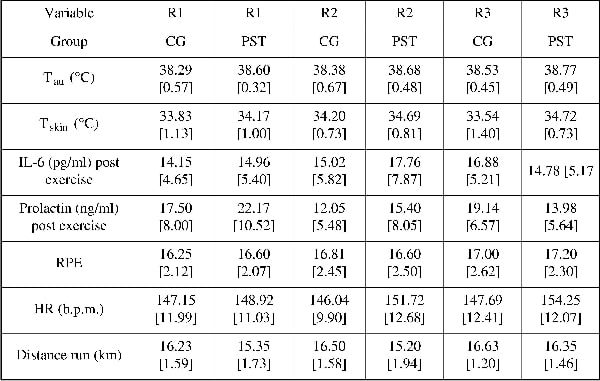Proposed mechanisms for early fatigue in the heat include changes in dopamine, serotonin and interleukin-6 (IL-6), exceeding critical thresholds in core temperature and impaired voluntary neuromuscular recruitment. Psychological factors leading to an urge to reduce exercise intensity or stop have received less attention: few interventions designed to improve performance in the heat (rehydration drinks, glucose mouth washes) have considered effects of psychological factors. We tested the hypothesis that a 5-day Psychological Skills Training (PST) package (Thelwell & Greenlees, 2003) would increase the distance covered before exhaustion during treadmill running in tropical heat. Eighteen healthy male participants were studied: a control group (CG; n=8; mean (s.d.) age 28 (5)yrs, height 1.73 (0.04)m, mass 72.83 (6.74)kg; % body fat 16.3 (3.24), [vdot]O2max 63.49 (6.17) ml kg min-1); an intervention group (PST, n=10; age 23(3) yrs, height 1.77 (0.05)m, mass 69.31 (6.06)kg, % body fat 14.38 (1.96), [vdot]O2max 67.06 (4.49)ml kg min-1). Subjects completed three 90-min treadmill runs (R) at 30.06°C (0.21) (41.40% (5.01) relative humidity); runs were separated by ≥4 days. During runs, subjects ran as far as possible, without feedback of time or distance. Subjects were assigned to CG or PST based on matched variability between R1 and R2 (km). PST over 5 days included goal setting, mental imagery, arousal regulation and positive self-talk aimed at improving distance run in R3. CG undertook R3 without any PST. Blood IL-6 and prolactin, an index of serotonergic activity, were measured. Core temperature (aural; Tau), mean skin temperature (Tskin = 0.3 (Tchest + Tarm) + 0.2 (Tthigh + Tcalf) and heart rate (HR) were recorded each minute whilst running. Rating of perceived exertion (RPE) was recorded every 15 min (Table 1). The hypothesis is supported; PST group ran significantly further (1.15km; 8%) in R3 compared to R2 (p = 0.002) or R1 (P = 0.006; ANOVA). This occurred despite a high RPE, and not via any of variables measured, which did not differ (P> 0.05). CG distance run was unchanged. The improvement in performance in the PST group puts into context results of other studies that do not employ a ‘blind’ experimental design. Psychological factors may underpin some of the improvement seen with unmasked interventions when subjects exercise in the heat.
University College London 2006 (2006) Proc Physiol Soc 3, C38
Oral Communications: Psychological skills training improves exercise performance in the heat
Martin James Barwood1, Avijit Datta1, Richard Thelwell1, Michael Tipton1
1. Institute of Biomedical and Biomolecular Sciences, University of Portsmouth, Portsmouth, United Kingdom.
View other abstracts by:
Table 1. Physiological responses to exercise in the heat
Where applicable, experiments conform with Society ethical requirements.

